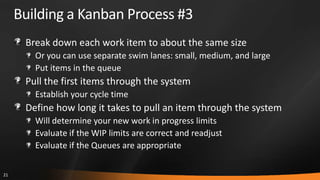Kanban
- 1. An Introduction to KanbanStephen ForteChief Strategy Officer, Telerik@worksonmypc
- 2. BioChief Strategy Officer of TelerikCertified Scrum MasterActive in the Community:International Conference Speaker for 12+ YearsRD, MVP and INETA Speaker Co-moderator & founder of NYC .NET Developers Group http://www.nycdotnetdev.comWrote a few books: SQL Server 2008 Developers Guide (MS Press)MBA from the City University of New YorkPast:CTO and co-Founder of Corzen, Inc. (TXV: WAN)CTO of Zagat Survey
- 3. AgendaDefining Agile and KanbanUsing Kanban to manage projectsHow to implement Kanban
- 4. AgendaDefining Agile and KanbanUsing Kanban to manage projectsHow to implement Kanban
- 5. Process and toolsIndividuals and interactionsFollowing a planResponding to changeComprehensive documentationWorking softwareContract negotiationCustomer collaborationoveroveroveroverThe Agile Manifesto–a statement of valuesSource: www.agilemanifesto.org
- 6. Back to the Basics“Agile” is about “values” not “rules” and rigid adherence to a processAgile is about embracing change
- 7. Influential Agile MethodologiesXP (The Past)Scrum (The Present) Kanban (The Future)
- 8. What is Kanban?An agile methodology that stresses pulling individual work items to completion Focuses on visualization Focuses on just in time delivery of raw materialsWorkers get what they need when they need it, no sooner (Lean)Limit Work in Progress
- 9. Where did Kanban Come From?Comes from the famous Toyota Production SystemPart of the Lean Manufacturing MovementPart of Six SigmaJapanese for “signal card”Kaizen-promotes continuous improvement
- 10. Kanban Cards
- 11. FlowKanban is about flowPull system- work is pulled through the system by demandBatch v flow (individual work items)Where there is inventory, there is no flowFlow and pull are linked:Keep the entire value stream moving towards the customer at the rate the customer consumes
- 12. AgendaDefining Agile and KanbanUsing Kanban to manage projectsHow to implement Kanban
- 13. Kanban for Technology ProjectsDefine a work flow and visualize itOrganize a queueLimit work in progress (WIP) for each queueAllows you to constantly evaluate process improvementsAllow work to flow through the system in a controlled way (not iterative) No sprints!Evolutionary by designChange is built into the modelCommunication is about flow
- 14. Core Practices of KanbanDefine and visualize the workflowLimit Work-in-progressMeasure and Manage FlowMake Process Policies ExplicitUse Models to Suggest ImprovementFor more info: http://finance.groups.yahoo.com/group/kanbandev/message/9261
- 15. Kanban
- 16. DemoKanban Board
- 17. AgendaDefiningAgile and KanbanUsing Kanban to manage projectsHow to implement Kanban
- 18. Building a Kanban Process
- 19. Building a Kanban Process #1Define a process flow Identify queues (swimlanes)Visualize it on a board
- 20. Building a Kanban Process #2Set your first work in progress limitsFirst time you *may* have to guess
- 21. Building a Kanban Process #3Break down each work item to about the same sizeOr you can use separate swim lanes: small, medium, and large Put items in the queuePull the first items through the system Establish your cycle timeDefine how long it takes to pull an item through the systemWill determine your new work in progress limitsEvaluate if the WIP limits are correct and readjustEvaluate if the Queues are appropriate
- 22. Building a Kanban Process #4Establish a delivery cadenceEstablish regular meetings/reviewsBorrow from Scrum/XP
- 23. Building a Kanban Process #5: KaizenConstantly improve your processDaily meeting facing the board to evaluate your flowContinue to tweak the WIP limits and queueFormalize the improvement processHave regular formal change meetingsRemember “be agile”
- 24. Kanban has few rulesNo daily scrumNo prescription for engineering practices No iterations No estimationUses metrics
- 25. Be careful!The lack of rules can lead to a lack of discipline But the lack of rules allows you to mix and match
- 26. ReferencesAnderson, Kanban in Action: http://www.agilemanagement.net/Articles/Weblog/KanbaninAction.htmlHiranabe, Kanban Applied to Software Development: from Agile to Lean: http://www.infoq.com/articles/hiranabe-lean-agile-kanban
- 27. Questions?



























